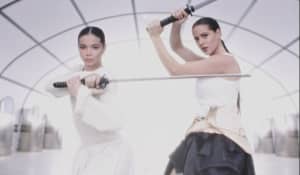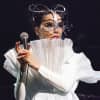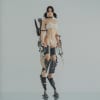What I remember most about Missy Elliott’s “The Rain (Supa Dupa Fly)” video—more than the sharp-cornered shots by director Hype Williams, Timbaland’s seesawing production, or the thick yellows, blues, and greens of the video’s backdrop—is how Elliott’s larger-than-life glossy black spacesuit swelled before me, contorting shapes and possibilities, as if Elliott herself would extend through the television and into my mother’s living room. I was 11 years old the first time I saw it, and though the video's cultural import was not immediately clear, I knew I had witnessed something major. Together, Elliott and Williams had created a new visual aesthetic that seemed to reimagine how a story could be told.
Last Wednesday, as I sat in the lobby of the Hilton Hotel in Downtown Austin with Kimberly Cooper, co-founder of Prologue Immersive—a Venice, California-based company that builds “content and software for medium-defining virtual and augmented reality experiences”—I thought of Elliott’s video, and how Williams might have pushed the limits even further given the existence of VR tech in 1997.
For Cooper, that’s what it's all about: testing the boundaries of form and creative vision. “VR is kind of like film and theater, but more interactive, more immersive,” she said, referring to how the technology allows for a convergence of mediums like never before. “And you have that tremendous opportunity of taking an artist, their music, and their whole identity, and putting it into this space. And what can you do with that? There are so many things—and not just on a visual level, but on a social level, on an economic level.”
Cooper co-founded Prologue Immersive as an extension of Prologue Films, a company she helped start in 2003 that has offered design and visual effects expertise to films like Iron Man, Seven, TRON, and Prometheus. What she and her team are proposing to do with PI is propel the medium, and its capabilities, to new heights. Which is to say: Cooper wants to offer a means of entry—into worlds both familiar and new—through immersion.
It could be said that the art form—music videos and the expansive ideas that drive them to fruition—got an upgrade last year with the release of Bjork's 360-degree interactive treatise, “Stonemilker.” When I ask Cooper if she’s seen any of the recent VR music videos, and what she thinks of them—like U2’s “Song for Someone” or The Weeknd’s “The Hills (Remix)”—she admits those concepts were “good” and “interesting,” before pausing to explain how VR, a technology that looks forward, might begin to provide users with the power to look back with a certain depth and vividness not yet experienced.
“I want to get even more… access,” Cooper said. “And when I say more access, I mean wouldn't it be great to have a VR experience with The Beatles, and kind of go back in time?”
Like time travel? I asked, equally baffled and intrigued.
It was at this point in our conversation that Cooper began to explain a world in which VR will permit us admission. Imagine, she said, being able to journey to November 30, 1982—the day Michael Jackson’s Thriller dropped—or to travel back in time and be in the studio when The Beatles or The Rolling Stones recorded their masterworks.
“My daughter sings, and I wish I could just say, ‘Go listen to Michael [Jackson], and see how you he wrote those songs or sung those songs back in the ’80s,' or, ‘Go put your VR on and experience it with The Rolling Stones.’ These were classics I grew up with that you can listen to on a record or on your phone,” she said. “But you can’t go back and really feel what it was like then.”
What Cooper was describing was a richer and fuller version of “immersion”—a word VR developers like to throw around when discussing the technology at conferences like SXSW Interactive. Her grand vision doesn't yet exist, but, with time, Cooper believes the technology will allow users to navigate the past with lifelike capabilities.
When I asked her what Prologue Immersive was working on as a means of offering more exhaustive experiences to potential users, she mentioned the company's partnership with possible artists—she won't say who just yet—and promised something revolutionary. “I grew up in the ’80s, so I know what it felt like. But my parents, they played Bob Dylan and The Beatles for me all the time. They were very ’70s parents. And there should be a way to go back to revisit those experiences in new ways.”
Like Cooper, David Karapetyan of Bipolar Id—a full service virtual reality production company based in Los Angeles—also believes VR can grant us unprecedented access to well-known and unexplored realms: from an interactive adventure built around your favorite novel to front-row seats for, say, a sold-out Little Dragon show at Madison Square Garden from the solitude of your living room.
“With VR you can even make the user a part of the music, which makes the experience more memorable and valuable,” Karapetyan said via email. To that end, Bipolar Id is currently working a troop of projects that involve placing “the user at the forefront of the [music video] experience as the main character” as well as a “live streaming solution for a major music festival in which users can experience the festival from home.”
Though Karapetyan was also tight-lipped as to which artists Bipolar Id was working with, his hopes for the medium, and the ways it might impact the music industry, remain high.
“Consumption for music in general will increase, as with VR there are no boundaries,” he said. “In this age of technology when attention spans are getting lower and multitasking is increasing, this is a rare feat which can be used to engage the audience completely.” Or as Missy Elliott might put it: Top down, loud sounds, see my peeps.


